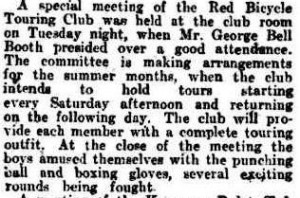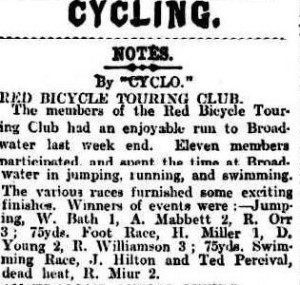 This week’s Sepia Saturday photo offers a variety of possibilities: pipes, pets, tortoises and hats (especially military). As luck would have it, I’d just come across this photo which I acquired as part of my aunt’s estate. I have no idea why she would have it, because the reverse shows it’s a photo from 1913, some years before either her husband or she were born.
This week’s Sepia Saturday photo offers a variety of possibilities: pipes, pets, tortoises and hats (especially military). As luck would have it, I’d just come across this photo which I acquired as part of my aunt’s estate. I have no idea why she would have it, because the reverse shows it’s a photo from 1913, some years before either her husband or she were born.

If you look carefully you will see that two of the men in the back row have their pipes lolling from the sides of their mouths, much as my grandfather used to do and several of the men are wearing spectacularly silly hats. What I love about the picture is the whimsical attitudes of the men, the casual clothes and the mix of seriousness and frivolity. A question I asked myself is what on earth the Red Bicycles Touring Club has to do with musical instruments but unfortunately I don’t have an answer.

I turned to my good friend Trove which came up with some interesting snippets, including the identical photograph, but presumably without the notations on the back (what do they mean?).

The Red Bicycles Touring Club was a cycling club based in Brisbane. From the stories I read it was part fun and definitely a large slice of seriousness. They were incredibly fit, riding in bike races, swimming, running, playing water polo, boxing and diving, interspersed with fun like blindfolded boxing! However they also had a club house at Cleveland, which is on Brisbane’s outskirts and on Moreton Bay. which they used for weekend camps of increasing popularity. I’m guessing that’s where this photo was taken hence the sky-larking element of it. It may even be from the December 1913 camp mentioned in The Queenslander.
I also found this more formal photo of the men from 1913. I’m assuming that the two photos should include all or most of the same men (there’s 10 in each picture) and it would be intriguing to see if the ones in the fun photo could be identified. According to the formal photo, the members of the club in 1913 were (back row) W Hurst, Dave Young, W Allen, F Johnson, B Muir, (front row): F Pryor, John (Jack) Hilton, F Campbell, Jim Dunning (see below) and S Gee. The members do seem to have changed a bit from year to year.


It’s interesting to compare the two photos and see if the same man can be identified in both. Although the club only commenced in 1910, it essentially shut down in 1914, only a year after this photo, as several of the members went off to war. I’d really like to know which of them served and whether any of them failed to return, but unfortunately with only initials to go by in most cases, it’s difficult to pin them down. Unfortunately the only ones named are generally those winning the prizes.
The Brisbane Bicycle Touring Association 2007 newsletter, page 4, quotes former RBTC member, Jim Dunning, aged 93: “The First World war caused the end of our touring club. Several of us joined the forces. We were in different units and lost touch with one another after we return. I rejoined

my racing club after I returned from the war, but as an official – I was too badly wounded for racing. I have not ridden a bike for nearly thirty years.” The WWI service records show that he suffered from a gunshot wound to the right arm.
So I suppose in the end there were two links between this photo and the Sepia Saturday topic: the pipes and the fact that some of these men would soon have been wearing the Australia Army’s slouch hats.

Lots of great info here, and some lovely photos.
LikeLike
Thanks Boobook.
LikeLike
An interesting post and I can see why you were intrigued. Mister MIke (Brubaker) may be the one to answer the musical instrument question for you.
LikeLike
Same thing I was thinking 🙂
LikeLike
Thanks Kristin and Little Nell…will have to pursue that option and get in touch.
LikeLike
Very interesting information here. Now to download the photos and compare faces.
LikeLike
I have a couple of theories, will be interesting to see how our thoughts compare.
LikeLike
Intriguing – and great altogether that you discovered so much from one photo! I Wonder why your mother had it ?
LikeLike
Yes it’s the connection that puzzles me the most.
LikeLike
A fascinating photograph. I see the fitness regimes of yesteryear didn’t preclude the odd beer or two.
LikeLike
Inevitably Brett…they looked like they were having a fun time didn’t they!
LikeLike
A great post, full of interesting opportunities for discovery. Blind boxing would be something to see!
You wonder what happened to them all after the war.
LikeLike
Indeed Helen, I’d like to follow it up if I could work out their first names. Apparently the blind boxing had them in hysterics of laughter.
LikeLike
Most of all I liked the juxtaposition of the scraggly, fun-loving group with the well-dressed, official-looking photo. Give me scraggly any day.
LikeLike
Me too, Joan on both counts, though it’s nice to “scrub up” occasionally.
LikeLike
That is a fun and funny photo, and the news clippings help flesh out their story.
LikeLike
A wonderful photo and great story. The instruments are a violin, cornet, and a bugle in the British army style. The back notation with the more recent date 6-6-85, and triangle -Register? P 27, 4 Col looks like a newspaper mark for page 27, 4 columns. Perhaps it was published in a local paper or magazine in 1985.
The little rifles may not be toys but actual guns that fired at targets or varmints (rabbits or wallabies?) I’m surprised no one commented on the photobomb boy in the background, which adds to the informal fun of the group. Cycling clubs start in the 1880s with the high wheel cycles and then move in the 1890s to the so called safety bicycle. I suspect that the British Empire contributed to the introduction of the bicycle to many parts of the world in this period.
LikeLike
Thanks so much Mike. Your comments are incredibly helpful. It never occurred to me that it might have been published in 1985, I just “assumed” (yes I know!) that it was 1885. It never occurred to me that it was a newspaper layout but it sounds entirely plausible. There are a number of papers which have Register in the name…a pity, the Australian genealogist’s friend Trove, only goes up to the mid-1950s. Yes I did see the boy in the background -I even wondered was I wrong, and the photo came from my grandparents because the image reminded me of my grandfather. Thanks for commenting.
LikeLike
I do like the idea of the Red Bicycle Touring Club. Some of these early bicycle-come-social clubs were fascinating organisations. I went to a play recently about the Clarion Cycle Club here in the UK, a similar organisation that combined cycling with fellowship.
LikeLike
How interesting Alan. Until I started Trove-ing for this I had no idea how big the cycle clubs were or how broad their “social” activities. I’d really like to know what happened to these men in the war.
LikeLike